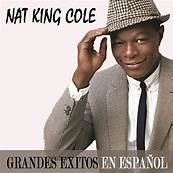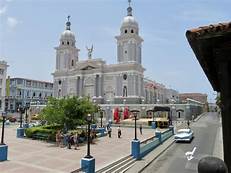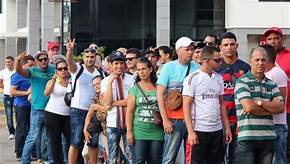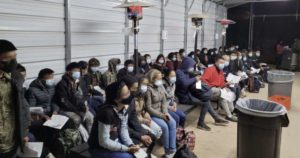TRIUNFOS DE NAT KING COLE EN CUBA. LA HABANA FUE PARA EL CANTANTE COMO UN OASIS. VIDEOS
En los años 50 Las Vegas estaba envuelta en todo un frenesí de casinos, música y espectáculos con los mejores artistas.

En aquel momento los mismos inversores norteamericanos que habían hecho surgir a Las Vegas de la nada en medio del desierto, habían visto ya en La Habana como un destino de mucha más ventajas que el enclave de Nevada y comenzaron en nuestra capital ha hacer grandes inversiones.
Es por ello que cuatro flamantes casinos competían en La Habana por ganarse la simpatía de los turistas norteamericanos, siempre numerosos en la Isla, de los cuales algunos sólo iban a pasar el fin de semana y otros solamente iban a jugar y se marchaban a la mañana siguiente, mientras otros estaban por tiempos mayores o residían en La Habana.
Y lo que tanto éxito les dió en Las Vegas como forma de atraer clientes, lo repitieron en Cuba, o sea, los suntuosos shows y espectáculos en sus cabarets.
LLEGADA DE NAT KING COLE A LA HABANA…
En febrero de 1956 la prensa cubana anunciaba la inminente presentación de Nat King Cole en el cabaret Tropicana.
Por ello la competencia no se podía quedar atrás, por lo que que por los mismos días en que Nat King Cole actuaba en la pista de Tropicana, Lena Horne lo hacía en el Montmartre y Tony Martin en el Sans Souci, como también lo hicieron otras figuras de la talla de Edif Piaf y Maurice Chevalier.
 VIDEOS- Nat King Cole canta ” Ansiedad”..
VIDEOS- Nat King Cole canta ” Ansiedad”..
Nat King Cole nos visito en Cuba en cuatro ocasiones, una de forma privada para conocer el escenario donde se presentaría, aunque de esa visita no hay muchos datos, y tres para cantar en el famoso cabaret.
Cuando llega a La Habana era, junto a Frank Sinatra los intérpretes más vendidos. Pero este acercamiento a la música cantada en español comenzó en Cuba.
No queda dudas de que este acercamiento a la música en español comenzó por La Habana, cuando realiza sesiones de boleros y chachachás con la Orquesta del cabaret Tropicana dirigida por Armando Romeu. En esos años, en la capital cubana, los tres grandes cabaret Sans Souci, Montmartre y Tropicana competían por las grandes producciones musicales y buscaban contratar a las figuras más exitosas internacionalmente.
Roderico Neyra (Rodney), sugiere al dueño de Tropicana, Martin Fox, que contratara a Nat King Cole, también como una forma de romper la barrera del color en Tropicana. acepta, pero sobre la base de una remuneración que, para la época, resultaba una fortuna.
Representantes de la dirección del cabaret con un equipo de periodistas y fotógrafos fueron hasta Miami para acompañar al cantante en vuelo especial en marzo de 1956, a bordo del Super G Constellations de Cubana de Aviación, el que se convirtió en un “Tropicana volante”, lo que impresionó a Nat King Cole, quien estaba acompañado de su esposa, su hija Nathalie, el peluquero, el jefe de estudio y de luces, el representante y un grupo musical (bajo, batería y piano).
 VIDEOS- Nat KIng Cole canta ” Aquellos Ojos Verdes”…
VIDEOS- Nat KIng Cole canta ” Aquellos Ojos Verdes”…
Nat se quedó impactado con la belleza de La Habana, era para el muy bella. Con su profesionalidad, organizó con su equipo un viaje de incógnito al cabaret para estudiar el lugar y el audio.
En cada presentación interpretó 37 canciones, siempre con un smoking y al final se sentó al piano para tocar jazz, lo que deleitó a los asistentes, ya que estaba entre los cuatro mejores pianistas del jazz del mundo.
A petición de Cole, Bebo Valdés interviene en ‘El bodeguero’ junto al percusionista Guillermo Barreto y la orquesta de Tropicana reforzada con violines de la Orquesta Sinfónica Nacional.
Ahí Nat se dio cuenta que la orquesta, bajo la dirección de Armando Romeu era una constelación de estrellas y con ella quiso grabar el disco. Después de las grabaciones se realizó una gran cena en la Bodeguita del Medio, lugar imprescindible para cualquier visitante ilustre. Y también fue una sensación en sus varios recorridos por la ciudad.
TRIUNFA EN LA HABANA EL CANTANTE…
Como se esperaba las actuaciones de Nat King Cole en Tropicana fueron todo un éxito. Su cálida y melodiosa voz, sobriedad de gestos y elegancia cautivaron, sobre todo, al público femenino. Fue tal la acogida, que el avispado y próspero empresario lo contrató para la temporada siguiente.
En febrero de 1957 Cole regresó a La Habana para cantar de nuevo en Tropicana. Se ha asegurado que fue el primer negro en romper la barrera racial en las tablas del cabaret, pero se olvida que Chano Pozo se había presentado antes, en 1941, con la bailarina rusa Tatiana Leskova en la producción “Congo Pantera”. También se ha escrito que las razones de su vuelta estaban vinculadas al dinero de Tropicana, pero en realidad Cole —a diferencia, por ejemplo, de estrellas como la Dandridge—, no confrontaba problemas económicos, estaba en el punto más alto de su carrera y no le faltaban ofertas de trabajo en los Estados Unidos. Lo cierto es que, al margen de los ingresos que pudo dejarle Tropicana —que desde luego no fueron de poca monta—, La Habana significó para él un lugar muy especial, una especie de oasis para el.

Armando Romeu, director de la Orquesta de Tropicana contaba que durante su actuación dialogaba con el público y de repente entraba a cantar en el mismo tono que lo hacía la orquesta, muestra de un oído musical excepcional.
El inmenso Bebo Valdés, dialoga sobre aquellas noches en Tropicana con Nat. Cuenta que él no tocaba porque lo hacía el King, y no necesitaba introducción de orquesta , entraba allí cantando y después caía la orquesta sin introducción alguna y cambiaba de un tono a otro con una maestría impresionante. El terminaba de cantar, aplaudían y empezaba directamente a cantar otra pieza en el tono que fuera sin ningún error. Bebo lo considera el artista más grande con quien ha trabajado.
En su segunda visita a Cuba y actuación en Tropicana se hospeda en el Hotel Nacional por dos semanas y una tarde se da una escapadita, en presencia de periodistas y cámaras de televisión, para visitar la fábrica de discos Panart, concesionaria de la Capitol. También llega hasta la discoteca de Fusté, en Amistad y Neptuno. Ya en Hollywood Ramón Sabat, presidente y dueño del sello cubano Panart había convencido al cantante para grabar en La Habana un disco completo en español, incluyendo algunos temas cubanos. Este registro fonográfico de una serie de temas serían clásicos en su discografía.
Hace más de 50 años Nat King Cole editó Cole Español impactando con un acercamiento a la música cubana y mexicana que ninguna otra gran figura de la canción norteamericana había abordado. Grabó tres discos en español, “A mis amigos”, en su tercer viaje a La Habana en 1958; en 1959 en México, “Cole en español” y en 1960 “More Cole” . Pero en 1949 ya había experimentado incluyendo al bongosero Jack Costanzo en su legendario trío de piano, bajo y guitarra, y graba Go Bong!.
Lo cierto es que Nat bailó en casa del trompo cantando boleros y canciones en español, y lo hizo magistralmente. Pero además de su éxito, ayudó a difundir la música cubana en lugares donde nunca antes se había escuchado.
NAT KING COLE REGRESA A LA HABANA…
Cole hizo un último viaje a Cuba en 1958, también para presentarse en Tropicana y para algo completamente nuevo: grabar su primer disco fuera de los Estados Unidos. Cierta historiografía le ha reprochado no haber interactuado más con la cultura cubana y sus agentes, como si no asistir a un bembé en un solar habanero o no participar en una descarga alrededor de una piscina del Country Club fuesen los indicadores últimos para medir su relación con nosotros. O como si no resultara suficiente haberse conectado con músicos de la talla de Armando Romeu, el pianista Bebo Valdés y el percusionista Guillermo Barreto, tanto en el escenario como en el estudio y la vida.

Nat “King” Cole, sin embargo, hizo algo mucho más importante: difundir la música cubana y latinoamericana urbi et orbi en los tres LPs de la Capitol Records donde cantó en la lengua de Cervantes: Cole Español (1958), A mis amigos (1958) y More Cole Español (1962). Ello incluía socializar la labor de compositores que él y su equipo habían calibrado cuidadosamente: Richard Egües (“El bodeguero”), Adolfo Utrera y Nilo Menéndez (“Aquellos ojos verdes”) y Osvaldo Farrés (“Quizás, quizás, quizás”), entre otros; por no mencionar su influencia en el filin, protagonizado por jóvenes compositores cubanos que fusionaron con lo suyo, guitarra en mano, tendencias musicales norteamericanas de la hora para producir algo distinto y diferente, una potencialidad que dista mucho de constituir agua pasada, porque sigue inscrita en nuestro disco duro cultural de hoy.
En La Habana se sentía libre. No solo por la interacción profesional y humana con artistas blancos y negros —eso, después de todo, también ocurría en los Estados Unidos—, sino además por su presencia en lugares públicos y restaurantes de La Habana Vieja (La Bodeguita del Medio) y El Vedado (H y 19) en los que no había una sección para un color y una para otro. Por eso buscaba contactos con los cubanos a nivel popular, donde la diversidad/mezcla racial resultan mucho más obvias, cuenta Arsenio Rodríguez.
Una invernal tarde [1957] el cantor se atrevió a recorrer la zona más populosa de la capital. Tomó un auto lujoso y pidió que lo llevaran a la llamada “esquina del dolor” (intersección de las calles Galiano y San Rafael), donde se encuentran las tiendas populares. Mi padre me contó que Nat llevaba un saco deportivo a cuadros. Un gran público se le abalanzó y le hacían saber lo mucho que apreciaban sus canciones.
Seguramente por cosas como esas, y por intimidades conocidas que se llevó a su tumba, Nat “King” Cole, amó a Cuba, “le gustaba ir a Cuba porque todo el mundo lo trataba como un hombre blanco”. Lo que equivale a decir, en lenguaje despigmentado: como a una persona.

*RECOMIENDENOS A SUS AMISTADES*
*PREFIERA A NUESTROS SPONSORS*

NAT KING COLE TRIUMPHS IN CUBA. LA HAVANA WAS LIKE AN OASIS FOR THE SINGER. VIDEOS
In the 1950s, Las Vegas was surrounded by a frenzy of casinos, music, and shows with the best artists.

At that time, the same American investors who had made Las Vegas appear out of nowhere in the middle of the desert had already seen Havana as a destination with much more advantages than the enclave of Nevada and began to make large investments in our capital.
That is why four brand-new casinos competed in Havana to gain the sympathy of American tourists, always numerous on the island, some of whom were only going to spend the weekend and others were only going to play and left in the morning. following, while others were for longer periods or resided in Havana.
And what gave them so much success in Las Vegas as a way of attracting clients, they repeated in Cuba, that is, the sumptuous shows and spectacles in their cabarets.
ARRIVAL OF NAT KING COLE IN HAVANA…
In February 1956 the Cuban press announced the imminent presentation of Nat King Cole at the Tropicana cabaret.
For this reason, the competition could not be left behind, so during the same days that Nat King Cole performed on the Tropicana track, Lena Horne did so on the Montmartre and Tony Martin on the Sans Souci, as did other figures of the stature of Edif Piaf and Maurice Chevalier.
 VIDEOS- Nat KIng Cole sings ” I’ll See you in Cuba”..
VIDEOS- Nat KIng Cole sings ” I’ll See you in Cuba”..
Nat King Cole visited us in Cuba four times, once privately to see the stage where he would perform, although there is not much information about that visit, and three to sing in the famous cabaret.
When he arrived in Havana he was, along with Frank Sinatra, the best-selling performer. But this approach to music sung in Spanish began in Cuba.
There is no doubt that this approach to music in Spanish began in Havana when he performed sessions of boleros and chachachás with the Tropicana Cabaret Orchestra conducted by Armando Romeu. In those years, in the Cuban capital, the three great cabarets Sans Souci, Montmartre and Tropicana competed for the great musical productions and sought to hire the most successful figures internationally.
Roderico Neyra (Rodney) suggests Tropicana owner Martin Fox hire Nat King Cole, also as a way to break the color barrier at Tropicana. he accepts, but on the basis of remuneration that, at the time, was a fortune.
Representatives of the cabaret management with a team of journalists and photographers went to Miami to accompany the singer on a special flight in March 1956, aboard Cubana de Aviación’s Super G Constellations, which became a “flying Tropicana”, which impressed Nat King Cole, who was accompanied by his wife, his daughter Nathalie, the hairdresser, the studio and lighting manager, the representative and a musical group (bass, drums, and piano).
Nat was struck by the beauty of Havana, it was very beautiful for him. With his professionalism, he organized with his team an incognito trip to the cabaret to study the place and the audio.
In each presentation he performed 37 songs, always wearing a tuxedo and at the end, he sat down at the piano to play jazz, which delighted the audience, since he was among the four best jazz pianists in the world.
At Cole’s request, Bebo Valdés takes part in ‘El bodeguero’ together with percussionist Guillermo Barreto and the Tropicana orchestra reinforced with violins from the National Symphony Orchestra.

There Nat realized that the orchestra, under the direction of Armando Romeu, was a constellation of stars and with it he wanted to record the album. After the recordings, a great dinner was held at the Bodeguita del Medio, an essential place for any illustrious visitor. And he was also a sensation on his various tours of the city.
THE SINGER TRIUMPHS IN HAVANA…
As expected, Nat King Cole’s performances at Tropicana were a complete success. His warm and melodious voice, his sober gestures and his elegance captivated, above all, the female audience. The reception was such that the clever and prosperous businessman hired him for the following season.
In February 1957 Cole returned to Havana to sing again at the Tropicana. It has been claimed that he was the first black to break the racial barrier on the cabaret stage, but it is forgotten that Chano Pozo had performed before, in 1941, with the Russian dancer Tatiana Leskova in the production “Congo Pantera”. It has also been written that the reasons for his return were linked to money from Tropicana, but in reality, Cole —unlike, for example, stars like Dandridge—, did not face economic problems, he was at the highest point of his career and he had no shortage of job offers in the United States. The truth is that, apart from the income that Tropicana could leave him —which was certainly not insignificant—, Havana meant a very special place for him, a kind of oasis for him.
Armando Romeu, director of the Tropicana Orchestra, recounted that during his performance he would dialogue with the audience and suddenly begin to sing in the same tone as the orchestra, a sign of an exceptional musical ear.
The immense Bebo Valdés talks about those nights in the Tropicana with Nat. He says that he did not play because the King did, and he did not need an orchestral introduction, he entered there singing, and then the orchestra fell without any introduction and changed from one tone to another with impressive mastery. He finished singing, they applauded, and directly began to sing another piece in whatever key it was without any mistake. Bebo considers him the greatest artist he has ever worked with.
On his second visit to Cuba and performance at the Tropicana, he stayed at the Hotel Nacional for two weeks, and one afternoon he took a short break, in the presence of journalists and television cameras, to visit the Panart record factory, a Capitol concessionaire. He also arrives at the Fusté nightclub, at Amistad and Neptuno. Already in Hollywood, Ramón Sabat, president, and owner of the Cuban label Panart had convinced the singer to record a complete album in Spanish in Havana, including some Cuban songs. This photographic record of a series of songs would be classics in his discography.

More than 50 years ago, Nat King Cole published Cole Español, making an impact with an approach to Cuban and Mexican music that no other great figure of North American song had approached. He recorded three albums in Spanish, “A Mis Amigos”, on his third trip to Havana in 1958; in 1959 in Mexico, “Cole en español” and in 1960 “More Cole”. But by 1949 he had experimented with including bongo player Jack Costanzo in his legendary piano, bass, and guitar trio, and he recorded Go Bong!.
The truth is that Nat danced at the top house singing boleros and songs in Spanish, and he did it masterfully. But in addition to his success, he helped spread Cuban music to places where it had never been heard before.
NAT KING COLE RETURNS TO HAVANA…
Cole made one last trip to Cuba in 1958, also to appear at the Tropicana and for something completely new: to record his first album outside the United States. Certain historiography has reproached him for not having interacted more with Cuban culture and its agents, as if not attending a bembé in a Havana lot or not participating in a download around a Country Club pool were the ultimate indicators to measure his relationship with us. Or as if it wasn’t enough to have connected with musicians of the stature of Armando Romeu, pianist Bebo Valdés and percussionist Guillermo Barreto, both on stage and in the studio and in life.
Nat “King” Cole, however, did something much more important: spread Cuban and Latin American music urbi et orbi on the three Capitol Records LPs where he sang in the language of Cervantes: Cole Español (1958), A mis amigos ( 1958) and More Cole Spanish (1962). This included socializing the work of composers that he and his team had carefully calibrated: Richard Egües (“El bodeguero”), Adolfo Utrera and Nilo Menéndez (“Those green eyes”), and Osvaldo Farrés (“Perhaps, perhaps, perhaps”), among others; not to mention his influence on the filin, starring young Cuban composers who fused with their own, guitar in hand, North American musical trends of the time to produce something different and different, a potential that is far from being past water, because it is still inscribed on our cultural hard drive today.

In Havana, he felt free. Not only because of the professional and human interaction with black and white artists —that, after all, also happened in the United States—, but also because of their presence in public places and restaurants in Old Havana (La Bodeguita del Medio) and El Vedado (H and 19) in which there was not a section for one color and one for another. That is why he was looking for contacts with Cubans at a popular level, where diversity / racial mix are much more obvious, says Arsenio Rodríguez.
One winter afternoon [1957] the singer dared to visit the most populous area of the capital. He took a luxurious car and asked to be taken to the so-called “corner of pain” (intersection of Galiano and San Rafael streets), where the popular stores are located. My father told me that Nat wore a checkered sports jacket. A large audience jumped on him and let him know how much they appreciated his songs.
Surely because of things like that, and because of known intimacies that he took to his grave, Nat “King” Cole, loved Cuba, “he liked to go to Cuba because everyone treated him like a white man.” Which is equivalent to saying, in depigmented language: as a person.
Agencies. MemoriasCubanas. Carlos RodriguezB. NatKingColeCuba. Extractos. Excerpts. Internet Photos. YouTube. Arnoldo Varona. www.TheCubanHistory.com
THE CUBAN HISTORY. HOLLYWOOD.

*RECOMIENDENOS A SUS AMISTADES*
*PREFIERA A NUESTROS SPONSORS*

 VER VIDEO- La Lupe Interpreta “ADIOS”..
VER VIDEO- La Lupe Interpreta “ADIOS”.. VER VIDEO- Fernando Albuerne canta “El Son se fue de Cuba”..
VER VIDEO- Fernando Albuerne canta “El Son se fue de Cuba”.. VER VIDEO- Blanca Rosa Gil canta ” Yo Soy la Buena”…
VER VIDEO- Blanca Rosa Gil canta ” Yo Soy la Buena”… VER VIDEO- Orlando Contreras canta “Amigo de Que”…
VER VIDEO- Orlando Contreras canta “Amigo de Que”…



















